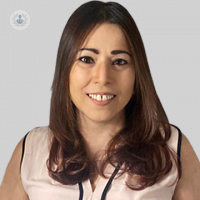Cluster vs normal headaches: what's the difference?
Escrito por:Cluster headaches are part of a group of headache disorders which can cause a great deal of pain and create a multitude of symptoms. Here to explain more about the condition is revered consultant neurologist Dr Mona Ghadiri-Sani.
What is a cluster headache and how does it differ from other headaches?
Cluster headache is one of the trigeminal autonomic cephalalgias. These are a group of headache disorders, which are usually strictly unilateral; always one-sided, affecting the same side of the head. They are one of the most painful headaches.

What are the symptoms of a cluster headache?
Cluster headaches are associated with autonomic features. The symptoms include:
- watering of the eye
- redness of the eye
- drooping of the eyelid
- watering of the nose
- congestion of the nose
- swelling around the eye
- feeling hot and sweaty
These are the symptoms that would be associated with trigeminal autonomic cephalalgias. However, cluster headache as a whole is a more severe form of these group of conditions. Cluster headache is usually episodic.
Patients suffering from cluster headaches describe a very severe pain, which is usually around the eye, in the temple, but it can also be at the side or at the back of the head. They usually describe a stabbing pain or like a screwdriver being put through their eye. The pain is extremely severe; its severity can be compared as giving childbirth. It usually affects males more than females.
What happens during the attack?
During the attack, patients become very agitated and restless, they can't stay still; they rock and move around. Sometimes when the headaches are so severe, they bang their head against the wall, put pressure on or even hit themselves; anything to stop the pain. The attacks can last anywhere from 15-20 minutes to up to a couple of hours.
Usually, the headaches are episodic; they can happen around the change of season, frequently around spring or autumn time, but they can occur anywhere at any time during the year. They can take place every day, for example, for several weeks and during that period you can have anywhere from one attack per day up to several attacks per day, and can also be nocturnal, waking you up during the night.
What triggers cluster headaches? How can they be avoided?
There have been several studies to try to discover why cluster headaches happen. They can occur because there is something pressing on the trigeminal nerve, which supplies the face and the side of the head. As a result of putting pressure on this nerve, you can cause stimulation, overactivity and sensitivity of the nerve which causes the headaches. This also causes activation of brain centres, in particular the thalamus, and the circadian rhythm, which determines the sleep pattern.
Lifestyle choices are important to both the triggering and prevention of cluster headaches. Alcohol is thought to be a very potent trigger during the cluster period, therefore it’s best if patients refrain from drinking alcohol, at least during this time. Taking too many painkillers can contribute to worsening cluster headaches, although this is not as common as in other headache disorders such as migraine. One of the treatments for cluster headaches is oxygen, but if you use too much oxygen, that can lead to a rebound headache, meaning that it is better to just use for acute attacks.
How are cluster headaches treated and how effective are the available treatments?
There are several different ways to treat cluster headaches. I would classify it into abortive and preventative measures.
Abortive measures are treatments that you take at the onset of each attack; for example, if you’ve woken up in the middle of the night and you want an abortive measure to try to stop that attack immediately. Measures to aid this include high-flow oxygen, which you can use for up to about half an hour.
Another option is triptan medication. Triptans are specific headache painkillers that can be used in the subcutaneous form, where you can inject yourself or in nasal form. These treatments act quickly to stop the attack.
As preventative measures, we can offer cranial nerve blocks, which are a combination of a local anaesthetic and steroids, given to the back (and sometimes the side and front) of the head. In the majority of patients they can be very effective in stopping the cluster altogether. They can take a week to take effect.
In patients who do not find cranial nerve blocks effective, other preventative medication, can be taken on a regular basis to reduce the frequency and the severity of the attacks. Usually, the first-line treatment for cluster headaches is verapamil. There are also epilepsy drugs and the newer CGRP monoclonal antibody treatments. These are newer, subcutaneous drugs which are administered once a month, and they are very effective in the treatment of headache disorders, primarily in migraines. However, there is some evidence demonstrating that they could be very useful in the management of other headache disorders like cluster headaches.
Are there any long-term complications associated with this medical condition? And how can they be prevented or managed?
Sadly, cluster headaches are known as suicide headaches, because unfortunately, some patients have committed suicide because of the severity and the frequency of the attacks. They can be quite debilitating and extremely severe. They are very debilitating when not managed properly and you're constantly in pain. With management, we try to get things under control, to minimise long-term effects.
If you are suffering from cluster headaches and would like to book a consultation with Dr Ghadiri-Sani, simply visit her Top Doctors profile today.


